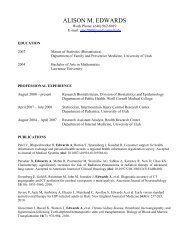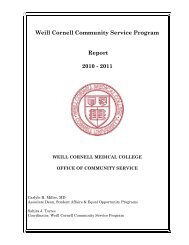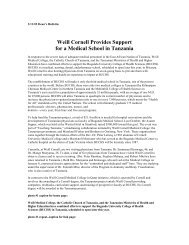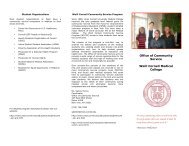Weillcornellmedicine - Weill Medical College - Cornell University
Weillcornellmedicine - Weill Medical College - Cornell University
Weillcornellmedicine - Weill Medical College - Cornell University
You also want an ePaper? Increase the reach of your titles
YUMPU automatically turns print PDFs into web optimized ePapers that Google loves.
they can comfortably ask patients about it.”<br />
Such an approach applies to active-duty<br />
military as well as veterans, she says—<br />
though she admits that it can be harder to<br />
get soldiers to open up. “We need to initiate<br />
programs to make it easier for people to<br />
get help,” she says. “It’s difficult, because<br />
they worry about stigma—that if they talk<br />
about mental health problems, somehow<br />
that will negatively affect the rest of their<br />
military lives.”<br />
Bruce notes that in an all-volunteer mil-<br />
Pediatric Pioneer<br />
Remembering Dr. Margaret Hilgartner<br />
itary, the population that enlists is selfselected—and<br />
therefore may have increased<br />
risk factors tied to their socioeconomic status.<br />
Today, many who join the armed forces<br />
come from poor backgrounds, enlisting<br />
because of a lack of employment options or<br />
to earn money for school. The same pressures<br />
they faced at home—and the same<br />
lack of resources—will be waiting for them<br />
when they return from their tours of duty,<br />
potentially upping the odds for future mental<br />
health problems. “It’s not random who<br />
<strong>Weill</strong> <strong>Cornell</strong> professor emerita of pediatrics Margaret Hilgartner, MD—a pioneer in<br />
hemophilia treatment and a barrier-breaking female physician—passed away on August<br />
19. She was eighty-three and died of complications from Parkinson’s disease. She is survived<br />
by her husband of more than fifty years, pediatrician Milton Arky, MD, a daughter,<br />
two sons, and six grandchildren.<br />
Hilgartner’s devotion to children fueled her passion for pediatric hematology and was the driving force<br />
behind her major contributions to the study of hemophilia. She was particularly interested in HIV’s effect on<br />
the growth and development of boys with hemophilia, and worked tirelessly to call attention to the HIV epidemic<br />
in the Eighties. Her research accomplishments included the first classification of hemophilic arthropathy,<br />
extensive work on complications of transfusion and infusion therapy, and studies of the infectious<br />
complications of HIV and hepatitis. But as pediatrics chairman Gerald Loughlin, MD, explains, her sympathetic<br />
nature was the key to her success as a physician. “Dr. Hilgartner was sensitive to the challenges faced<br />
by patients who had chronic conditions and needed blood transfusions, yet still wanted to be teenagers and<br />
go to proms,” says Loughlin. “I think that sensitivity drew her to being a pediatrician.” Loughlin notes that<br />
Hilgartner’s accomplishments are particularly noteworthy for a female physician working in the Fifties and<br />
Sixties. “She was a strong person, and that was important,” says Loughlin. “There was a glass ceiling.”<br />
Hilgartner was born in Baltimore on November 6, 1924. She earned a BA from Bryn Mawr and a master’s<br />
in zoology from Duke; when she graduated from Duke’s medical school in 1955, she was one of just<br />
three women in her class. She completed residency and fellowship training in pediatric hematology at New<br />
York Hospital/<strong>Cornell</strong> <strong>Medical</strong> Center, serving as director of the Hemophilia Comprehensive Treatment<br />
Center from 1970 to 1995. She later became chief of the Division of Pediatric Hematology/Oncology and<br />
was a driving force in the Children’s Blood Foundation, serving as president from 1992 to 1995. “She had<br />
the presence, stature, intelligence, foresight, and pioneering spirit to make her a giant in the field,” says<br />
pediatrics professor Donna DiMichele, MD, Hilgartner’s successor at the hemophilia center. Hilgartner was<br />
also chief of the health department in Tenafly, New Jersey, where she and her family lived.<br />
As friends and family noted at her <strong>Weill</strong> <strong>Cornell</strong> memorial service in November, Hilgartner led an active<br />
life outside of work. She loved fine dining, needlepoint, and the ballet; she was an avid gardener and ice<br />
skater, and always made time for her children and grandchildren. Even more than her success as a physician,<br />
this equilibrium between work and home is what impressed DiMichele most. “She had a robust life<br />
outside the hospital,” says DiMichele. “She had real balance in her life. It was probably her greatest accomplishment.”<br />
Loughlin lauds Hilgartner as a strong mentor to young faculty, calling her “a tremendous role model.”<br />
DiMichele says she will always remember one particular interaction with Hilgartner, shortly after DiMichele<br />
first came to <strong>Weill</strong> <strong>Cornell</strong>. She was hesitant to treat a certain hemophilia patient aggressively—but<br />
Hilgartner jokingly told her, “Oh, go take a Valium and treat the patient.” Says DiMichele: “I never took<br />
that Valium, but I did treat the patient. Those simple words gave me the courage to be the physician that<br />
I am. I will always remember her for that—for her frankness, her sense of humor.”<br />
— Justin Reed<br />
goes into wars and who are veterans, at<br />
least not since we had a draft—and even<br />
then it wasn’t exactly random,” Bruce says.<br />
“If people now going into the Army are<br />
coming from less advantaged groups, and if<br />
they’re at higher risk for illnesses and stressors,<br />
then that’s going to be with them their<br />
whole lives. So it’s particularly important<br />
that we provide the best care and the<br />
resources needed to reduce the risk of suicide<br />
when possible.”<br />
— Beth Saulnier<br />
‘She was<br />
sensitive to<br />
the challenges<br />
faced by<br />
patients who<br />
had chronic<br />
conditions, yet<br />
still wanted to<br />
be teenagers<br />
and go to<br />
proms.’<br />
Margaret Hilgartner, MD<br />
WINTER 2008/09 19












